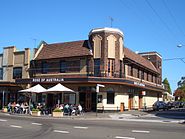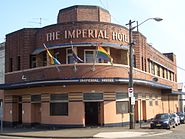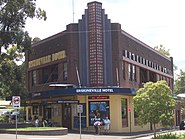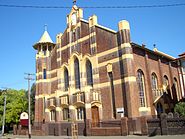| Erskineville Sydney, | |||||||||||||
 Terrace of Victorian homes, Bridge Street | |||||||||||||
| Postcode: | 2043 | ||||||||||||
| Location: | 3 km (2 mi) south of Sydney CBD | ||||||||||||
| LGA: | City of Sydney | ||||||||||||
| State District: | Heffron, Marrickville | ||||||||||||
| Federal Division: | Sydney | ||||||||||||
| |||||||||||||
Erskineville is an inner-city suburb of Sydney, in the state of New South Wales, Australia. Erskineville is located about 3 kilometres south of the Sydney central business district and is part of the local government area of the City of Sydney. Erskineville is informally part of the region of the Inner West, but is also more correctly considered to be part of the Inner City because of its proximity to the city. Erskineville is colloquially known as Erko.
Erskineville is bordered by the suburbs of Newtown to the west, Eveleigh to the north, St Peters to the south, and Alexandria to the east. The locality of Macdonaldtown sits over the north-west border.
Erskineville is a residential suburb with a village-type atmosphere. It has a small shopping strip around the railway station and several popular bars and hotels including the Rose of Australia, the Imperial Hotel, Erskineville Hotel, the Hive Bar and The Kurrajong. Erskineville is a popular location with residents because of its proximity to the city, cafes and village atmosphere. These features also make real estate expensive in this area, considering the small size of most properties. Erskineville Oval is located on the eastern border of the suburb.
History[]
The suburb was originally called after an earlier subdivision in 1846 in the south of Erskineville owned by Stephen Macdonald. The streets around the early Macdonaldtown subdivision are named after relations of the Macdonald family - Amy, Flora, Eve, Coulson and Rochford. Knight Street is named for Henry Knight, one of the earliest brickmakers in the district and the first mayor of Macdonaldtown. Devine Street is named for the first grant holder, Nicholas Devine, the first principal superintendent of convicts. He called his property Burren Farm, after his county in Ireland.
Erskineville is named after Erskine Villa, the home of Wesleyan minister, Reverend George Erskine, built in 1830. After changing owners a few times, the property was eventually left to the Church of England and became the rectory for the Holy Trinity Church at Macdonaldtown. In 1893 Macdonaldtown was renamed as the Borough of Erskineville.[1]

Sydney Park Road
It is not to be confused with the Mandurah suburb of Erskine.
In the late nineteenth century, the inhabitants were originally market gardeners, though brick making and tanning also became dominant industries. The Victorian cottages and small rows of Victorian terraces that dominate the built form of the suburb were the homes of the workers in these industries, which explains their smallness: a four-metre wide terrace is large by Erskineville standards.
In the early twentieth century, manufacturing in the area diversified, and Erskineville became a resolutely working class inner city suburb, with a proud history of resistance, and a less proud history of street violence. After World War II, Greek and Macedonian migrants found it an affordable place to settle, near the city.
From the 1970s, Erskineville underwent gentrification with new residents attracted to the village atmosphere, the excellent public transport links (three railway stations on two different lines within walking distance) and the proximity to Newtown. The gay and lesbian community were part of the first wave of gentrification and are still a component of the community. As the terrace houses were renovated, the narrow streets were cobbled and speed-bumped and an urban forest of plantings grew in the streets and pocket parks.
Transport[]
Trams[]

Tram at the Erskineville terminus
The Erskineville line opened as an electric double track tramway in 1909. It branched from tracks at Regent Street in Chippendale, and passed west along Meagher Street, then south into Abercombie Street. It followed Abercrombie Street south across the junction with Cleveland Street through Golden Grove, before swinging south into Golden Grove Street then right into Wilson Street. The line then passed under the railway lines at Burren Street, adjacent to the entrance to Macdonaldtown railway station. The line then became a single track loop passing up Burren Street to Erskineville Road, then west along Erskineville Road to Septimus Street, then Albert Street before rejoining the tracks at Burren Street. Services operated from Circular Quay using the Pitt and Castlereagh Street lines. The line south of [Cleveland Street closed in 1940, with the northern section used by other services until its closure in 1958.
The Henderson Road line was a short line that branched from the Alexandria line tracks at the corner of Henderson and Mitchell Roads in Alexandria and passed along Henderson Road to Park Street in Erskineville, and later to Bridge Street adjacent to Erskineville railway station. Services operated from Circular Quay with the line opening to Park Street in 1906 and to Bridge Street in 1909. The line was an electrified single track throughout. The line was an early closure in 1933 and was replaced by a private bus service that no longer operates.
Present day transport[]

Erskineville Road
Erskineville railway station is on the Bankstown line of the City Rail network. Towards the city the stops are: Erskineville, Redfern, Central, Town Hall, Circular Quay, Wynyard and it takes around 5 minutes to reach Central Station. Newtown railway station and Macdonaldtown railway station are also within close walking distance. Buses provide a service from Marrickville Metro shopping centre at Marrickville to Surry Hills.
Popular culture[]
- The Imperial Hotel at Erskineville is the famous drag show pub featured in the movie Priscilla, Queen of the Desert.
- Erskineville and the Inner West area were featured in the indie film, Erskineville Kings, one of the last projects that Hugh Jackman worked on before he was offered the role of Wolverine in X-Men, henceforth becoming a Hollywood movie star.
- Famed retro hard rock band Wolfmother was raised and formed here.
Notable residents[]
- Paul Mac, musician and DJ. the Dissociatives
- Daniel Johns, silverchair and the Dissociatives
- Natalie Imbruglia, former wife of Daniel Johns, singer and former actress
- Wolfmother's Andrew Stockdale, Myles Heskett and Chris Ross came from Erskineville [2]
- Urthboy, Australian solo hip hop artist and member of the herd
- John Prior, musician, composer and producer. Matt Finish, Adrian Belew, Yungchen Lhamo, Jackie Orszaczky and The Erskinevillains
- Jackie Orszaczky, musician, orchestrator, composer, bandleader
- John Kennedy, singer/songwriter of King Street, Miracle (in Marrickville). John Kennedy's Love Gone Wrong
- Jon Cleary, novelist
See also[]
- Dawn O'Donnell
- Newtown area graffiti and street art
Gallery[]
References[]
- ^ The Book of Sydney Suburbs, Compiled by Frances Pollen, Angus & Robertson Publishers, 1990, Published in Australia ISBN 0-207-14495-8, page 102
- ^ http://www.smh.com.au/articles/2004/10/12/1097406556886.html?from=storyrhs SMH article on Inner West musicians
External links[]
| |||||||||||
| This page uses content from the English language Wikipedia. The original content was at Erskineville, New South Wales. The list of authors can be seen in the page history. As with this Familypedia wiki, the content of Wikipedia is available under the Creative Commons License. |








